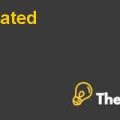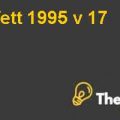
Examine the types of securities being recommended to RJR as financing alternatives in August, 1985.
R. J. Reynolds is under consideration to raise $1.5 billion to finance its acquisition of Nabisco. It has options to raise the finance through equity by issuing common shares, bank financing and finally commercial paper financing. These three are the means that are widely used to finance under the corporate financing structure. The company holds a status of being one of fortune 500 companies; therefore the debt financing does not seem to be difficult for it in local, foreign and Euro markets.
However, the company is profitable and it has also acquired a profitable company, therefore the equity financing seems to be a less worthy decision for its current shareholders (Exhibit 3&4). The debt financing is for the shorter period, thus it is more favorable than equity financing.
The debt financing has the shortest period due to high potential of the company to pay off the debt in a shorter period. The financing should be a maximum of 10 years and less than this is more acceptable.
It is described that the financing through international currency can be more favorable due to the reason of low interest rate offerings by Japanese Yen and other currencies.
The favorable rates for Eurobonds are given in USD denominated currency. The company is attractive; therefore the finance can be raised through the help of local banks and foreign banks to facilitate the financing arrangement. The Euro bonds are favorable to finance the debt of $1.5 billion.
Assuming that RJR decides to issue a 5-year offshore bond, which one of the six alternatives in an excel sheet.
Offshore bonds are the financing of bonds hold a tax advantage wrapper, these bonds can be offered outside the country boundaries.
While issuing bonds, there are many things that must be considered before going through bond financing structure. It is the technical method of financing as compared to the traditional financing method to raise finance from investment banks and other financial institutions.
In bond financing, the first thing to be considered is the annual coupon payments, the annual coupon payments largely affect the annual cash flows of the company.The. lower the coupon rate from market yield, the higher the discount rate it has to offer at the time to issue bonds. The yield has an inverse relationship with the market price of the bond therefore market price must be considered to fulfil the financial targets.
The bonds are not issued free of cost, the investment banks charge a fee on the bond issues to facilitate the bond issuance in the international currency, therefore these costs must be considered. The cost of issuance is adjusted under the yield calculation or internal rate of return of the specific bond. Under internal rate of return is the yield of the bond, including all cash inflows and outflows in the local currency i.e. USD. The net receipt in that case is deduced from the amount receipt to get an effective rate of interest.
The company has chosen to raise finance through Eurobonds by issuing it in the international market, in this case there are many things must be considered specially foreign exchange rates. However, the yield in Japanese Yen is lower than that USD, but the impact of foreign exchange and issue cost may make the decision less attractive.
The effect of exchange rate risk must be undertaken while going for the Eurobond fund raising method. The forward rate agreements and swaps are used to minimize the forex risk over the value of the company and its bonds. The higher repayment can affect the acceptability of accepting the Eurobonds.
It has total 6 methods to hedge the forex risk for the capital repayment and coupon payments. The method to analyze the options must base upon the required return, i.e. IRR; the option having less IRR must be selected to get benefits from lower yield to the company.
The most suitable option is option number 5, dual currency bonds with final payment hedge into Yen and then all cash flows swapped in USD. This has a less IRR in $ terms, the reason behind such results is the effect of final payment and other risk minimization through currency swaps.
On current receipt, it has received a better amount, but through swap contracts, it has an option to eliminate any of the risk of payment above the budgeted amount allocated under appendix 6. The risk is most secured in this option as compared to the other options and the IRR is also the lowest in option number 5................
This is just a sample partial case solution. Please place the order on the website to order your own originally done case solution.












